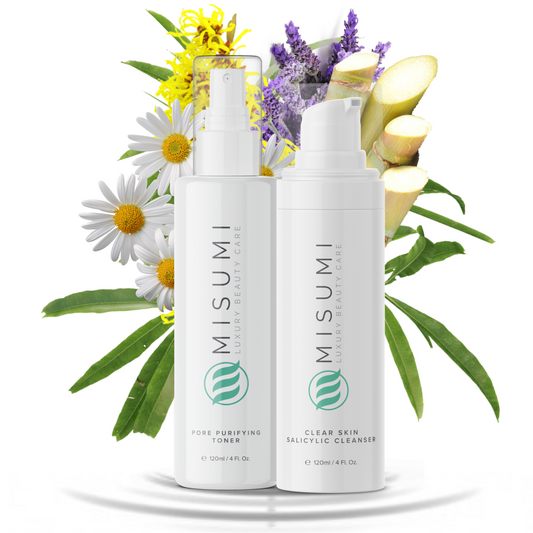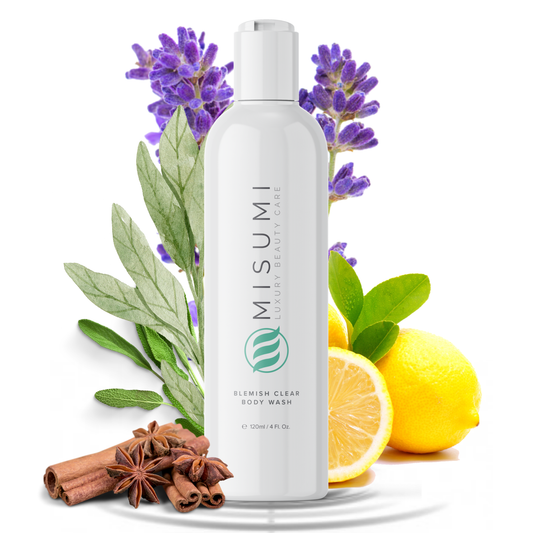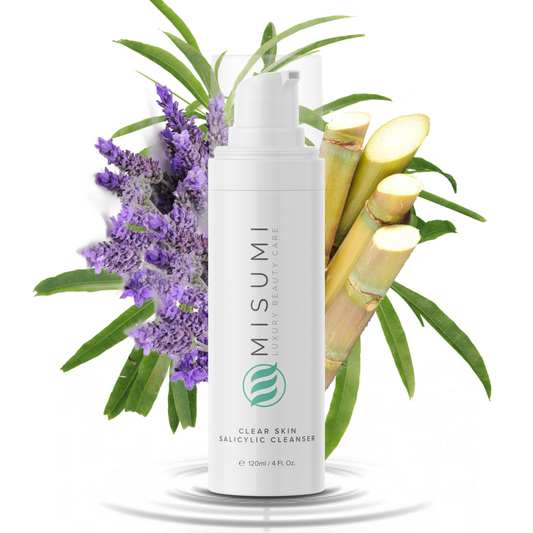Those who've ever had to deal with dry skin know the difficulties of keeping your skin properly hydrated at all times. There are so many options out there for dealing with these issues, ranging from oils to moisturizers.
Today we'll be discussing the hydrating powerhouse called squalene (or squalane). You may not have heard of it before, but the benefits of squalane are endless. It's not just a moisturizer - it's so much more.
What Is Squalane?
Squalane is a byproduct of squalene. Squalene is a hydrocarbon that our body produces naturally, just like collagen and hyaluronic acid. Our bodies contain as much as 13% of squalene.
Like collagen, the amount of squalene in our skin lowers as we grow older, so it's important for our skin to tap into other resources when it needs extra hydration. Keeping this in mind, it's wise to start using various resources of squalene and squalane as early as our mid-twenties. These resources can be found both in food and in topical products.

If you're a fan of using natural oils on your skin, then using squalane will not be a difficult transition. But some people feel uneasy about putting oil directly on their skin, particularly the face area. You might not check the ingredient list on your favorite skin care products, but many of them contain some kind of oil, particularly squalane.
In the past, this ingredient was primarily obtained by using shark liver oil. Today, thanks to modern technology, it's not required to tear down shark livers to get high amounts of squalene. Instead, it's easily taken from plants and made into a substance that continues to be used either in isolation or in conjunction with other ingredients.
Squalane works by mimicking your skin's oil, protecting the skin barrier, and keeping it moisturized.
Many products, such as moisturizers, creams, and serums, contain squalane as a source of natural moisturizer. It's recommended to use at least one of these products that contain squalane or use it in isolation, as the methods below demonstrate.
Which Food Contains High Amounts of Squalene?
Other than our bodies, squalane is also found in olives, wheat germ, amaranth, sugarcane, and rice bran oil.

To boost your squalane levels, incorporate more squalane into your diet. Adding extra virgin olive oil, the Mediterranean wonder, to your next salad is an easy way to go. You could also cook up some amaranth and add some vegetables for an extra vitamin boost.
The Difference Between Squalene and Squalane
You might have come across these two phrases and wondered whether it's just a typo or if there's a difference between these two terms. Well, there is one! Squalane is made from hydrogenating squalene. Because of this, squalane becomes firmer and has a higher melting point than previously.
Their formulas are pretty similar in terms of what they're made of and their consistency. However, hydrogenated fats are not so easily accepted by the skin and can be more comedogenic. One of the best benefits of squalane is that it has a longer shelf life than squalene.
More on that later.
Benefits of Incorporating Squalane in your Skincare Routine
If you're not yet convinced about using squalene in your regular skin care routine, you might change your mind once you see all the skin issues it can help with and all the healthy ways it impacts the skin.
Continue reading to discover all the great squalane oil benefits.
A Prime Moisturizer
Everybody needs a little moisture in their life - even if you have extremely oily skin. Oily skin types also get a smaller amount of squalane as they age, so a change in skin types is likely to occur. It's not uncommon for people to change skin types in their thirties, especially as the skin's natural oils start to decline. (When this happens, you may need to change up your skin routine.)
Squalane can help with all sorts of skin conditions naturally since it's already found in our bodies.
Lots of things can lead to dry skin, including environmental stressors. If you have dry skin, it can help immensely by providing constant moisture. If you suffer from dry patches or chapped lips during the winter, it will help you battle these common symptoms of cold weather. If you have combination skin, it will treat the dry areas on your face - most often the cheek areas and peri-oral (around the mouth). It's really that easy to get hydrated skin.
Antibacterial Benefits
Squalane has natural antibacterial properties. If you suffer from blemish-prone skin, acne, or other skin concerns such as eczema, psoriasis, and dermatitis, it treats the bacteria causing your skin issues, prevents irritation and helps you achieve healthy looking skin.
Bacteria are tricky to deal with. Many patients who suffer from acne or any other problems relating to the skin are prescribed antibiotics. They can certainly be helpful while taking them, but once you go off them, your issues return because the root problem isn't addressed. And what's even worse is that you can develop antibiotic resistance if your skin grows accustomed to this medicine.

Squalane is a safe bet. It leaves skin hydrated (but not oily), and you can use it regularly and for a long period of time.
Squalane Is Non-Comedogenic
The most important thing when choosing a skincare product is seeing how high it scores on the comedogenic scale. Lucky for us, squalane is non-comedogenic and scores pretty low. This means it's not likely to cause any acne and spots. It's suitable for any skin type out there, even sensitive skin.
Since the oil is absorbed slowly into the skin, it doesn't leave the skin greasy and shiny-looking after you've applied it, which is probably the worst feeling when it comes to oil application.
Because it's non-comedogenic, you probably won't have any issues regarding its application. If this is the first time you're using squalane, it's wise to do a patch test before applying it on your whole face. If the majority of the population responds well to a product, chances are so will you. But, just to be cautious, apply it to a small area of your face for a couple of days and see how you react to it. If you don't see any redness, itching, or blemishes, you're good to go.
Anti-Aging Properties
Did you know that dry skin types are more prone to premature signs of aging than oily skin types? When the skin is deprived of moisture for longer periods of time, it's more likely to wrinkle. So, how can you avoid this? One of the answers is by using squalane regularly.
Unlike other oils, it keeps mature skin hydrated without clogging up the pores. If you're using it as a moisturizer, it will not only hydrate the skin but also soften it, reducing the appearance of any premature signs of aging, like fine lines and wrinkles.
If you're looking for a natural and effective anti-aging product, try giving squalane a go.
Squalane as a Tool for Battling Harmful Radicals
According to this study, this ingredient can fight free radicals and prevent oxidative damage to the skin, which is one of the most harmful processes our human body goes through. It leads to much trouble, like premature aging, acne, and dark spots. It's no secret that these radicals bring havoc to our bodies, but our skin also suffers.
By applying squalane to the skin regularly, you're preventing oxidative damage from occurring in the first place, which is super important if you're after healthy and glowing skin.

Squalane Protects Against Harmful UV Rays
We've all heard how important applying sunscreen is. UV rays cause as much damage as free radicals do, although the effect isn't as immediate. Excessive sun exposure can not only lead to sunspots but can also cause skin cancer, and you don't want to risk that.
The best way to avoid premature signs of aging and hyperpigmentation is not only through applying sunscreen each time you get out in the sun but also by incorporating products such as squalane in your regular skincare routine, which will help fight off these issues.
Squalane can also treat dark spots and hyperpigmentation, so if you're already suffering from any of these, you can also incorporate it into your routine. It works not only as a preventative measure but also as a treatment.
Can I Use Other Products in my Routine While Using Squalane?
If you're careful about the skin care products you put on your face, chances are you're already well aware of how they can cross-react with each other and not only mess with your progress but also cause unwanted side effects.

Luckily, with squalane, you won't have to worry about that. The good news is that squalane doesn't interfere with other products you might be using. This means that whatever your skincare routine is currently, you can only benefit from adding in squalane.
Using Squalane as a Part of Your Skincare Routine
Now that we've seen all the amazing things squalane can do for our skin, let's explore all the different ways you can incorporate it into your regular routine. From oil cleanser to moisturizer, you'll find it everywhere.
Using Squalane as a Moisturizer
If you want to increase the amount of squalane in your body or use it primarily for its moisturizing benefits, start by applying the oil directly on your skin a couple of times a week. Once your skin gets used to it, increase the application by using it every night.
It's easily absorbed into your skin and won't cause any irritation, so you don't need to worry. Squalane produces a barrier between the skin and the environment, so it's a good idea to use it before leaving the house to protect your skin against any environmental pollutants such as dust and pollution.
Another option is to buy a regular moisturizer that already contains squalane in it. This will also ensure that you get the proper moisture that your skin deserves, but it will also be more convenient for application.
Using Squalane for Hyperpigmentation and Spots
As we've mentioned before, squalane has the unique benefit of helping treat hyperpigmentation and dark spots, conditions which many people suffer from, particularly those who've already had acne at some point in their life.
Using a product that contains squalane for a certain period of time can potentially fade these dark spots over time and protect new ones from forming. On top of that, using squalane oil for the skin will ensure that it's protected from within, so you'll be effectively dealing with any occurring skin issues in the long run.
When it comes to hyperpigmentation, it's important to stay consistent and patient with the methods you're using.
Squalane as an Anti-Aging Product

We've gone over the amazing anti-aging benefits of applying squalane topically. Add a product or two that contains squalane as a part of your routine, whether you're already experiencing fine lines and wrinkles or want to protect your face from any that might occur.
If you want a full-blown anti-aging routine, you should consider using Retin A in addition to squalane. Try this amazing Retinol Intense Repair PM Creme!
Squalane, Turmeric and Papaya Face Mask
Are you looking for a way to spice up your current skincare routine? It's understandable. Applying the same skincare products over and over again can be boring, especially for those who want to experiment with their products regularly.
Spice up your everyday skin care routine with this easy DIY mask you can make at home. For other DIY ideas, click here.
Papaya has antioxidant properties (and its seeds are rich in monounsaturated fatty acids.) Using this natural antioxidant gives your skin elasticity and increases collagen levels, making it amazing for achieving anti-aging benefits. Turmeric, on the other hand, is an anti-inflammatory and antibacterial powerhouse. It helps get rid of blackheads and dead skin cells.
These two ingredients are already extremely popular within the skincare community, so try this mask out for yourself and see why firsthand!
For this mask, you’ll need:
Mix all these ingredients and apply the mixture to clean skin. Let the mixture sit for about 20 minutes before washing it off with warm water. It's best to use this mask no more than three times a week for beautiful skin.

Other Ways You Can Apply Squalane
Squalane can also be used in various other ways, which can be beneficial if you're into practical products.
If you're suffering from dry cuticles, try adding a drop or two of squalane to your fingertips and massaging your cuticles with it. This will not only moisturize them but also help with the nail polish removal process.
Another productive way to use it is by putting it on your hair. Squalane oil for hair can result in many benefits, like helping repair split ends and softening your hair. You can apply it on both wet and dry hair.
Side Effects
Squalane is skin-friendly, and there are little to no side effects from using it topically. You might experience some irritation and redness, but this is very rare.
If you're an environmentalist or a vegan, make sure you purchase cruelty-free squalane products from plant sources since extracting it from shark livers is damaging to our ecosystems and downright cruel. Plant-derived squalane (such as olive-derived squalane) is much safe and better for the environment.
Final Thoughts
Using squalane is a sure way to bump up its amount in our body. It has incredible benefits, ranging from aging and hydrating ones to perks for acne-prone skin. If you're unsure about using it on your skin, you can always consult a board-certified dermatologist.
References
Biological importance and applications of squalene and squalane








